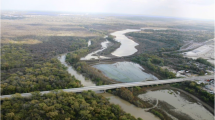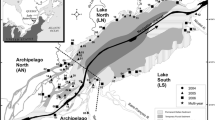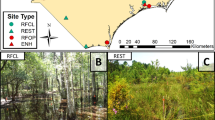Abstract
We quantified macroinvertebrate community characteristics in nine temporary or permanent wetlands, and related these to environmental conditions. Macroinvertebrates inhabiting the water column and shallow sediment (42-cm depth) were sampled 20 months after wetland construction in June 2005. A total of 29 taxa were collected, and macroinvertebrate communities varied among wetlands. Total macroinvertebrate biomass (mean ± SE = 16.44 ± 4.72 g AFDW/m3) and densities (mean ± SE =372,096 ± 124,972 individuals/m3) were positively related to coarse particulate organic matter abundance (living and nonliving plant matter; CPOM) and negatively related to turbidity. Density of ecologically sensitive EOT (Ephemeroptera, Odonata, Trichoptera) taxa was also positively related to CPOM and negatively related to turbidity. Total taxa richness was negatively related to turbidity, and percent of total macroinvertebrate density consisting of EOT (% EOT) was positively related to CPOM. These relationships were greatly influenced by 10 dominant taxa (nematodes, physid snails, mites, small squaregill mayflies, narrowwinged damselflies, biting midges, non-biting midges, ostracods, cladocerans, and cyclopoid copepods) that were positively associated with CPOM and negatively related to turbidity. Two wetlands inhabited by common carp (Cyprinus carpio) appeared to be in the poorest condition. These wetlands had the lowest macroinvertebrate biomass and densities and highest turbidity. Additionally, although net uptake of total nitrogen (TN) occurred in these high-turbidity wetlands, NH3 concentrations were two-fold higher in outflow than inflow. Net uptake of total phosphorus (TP) occurred only in wetlands with low turbidity, high CPOM abundance, and high macroinvertebrate abundance and diversity. To enhance macroinvertebrate abundance and diversity and ecological functions (e.g., nutrient removal) in newly constructed wetlands, management efforts should be directed toward increasing plant abundance and reducing turbidity.
Similar content being viewed by others
Literature Cited
APHA. 2005. Standard Methods For the Examination of Water and Wastewater, twenty-first edition. American Public Health Association, New York, NY, USA.
Bailey, R. C., R. H. Norris, and T. B. Reynoldson. 2001. Taxonomic resolution of benthic macroinvertebrate communities in bioassessments. Journal of the North American Benthological Society 20: 280–86.
Barnes, L. E. 1983. The colonization of ball-clay ponds by macroinvertebrates and macrophytes. Freshwater Biology 13: 561–78.
Batzer, D. P., R. Cooper, and S. A. Wissinger. 2006. Wetland animal ecology. p. 242–84. In D. P. Batzer and R. R. Sharitz (eds.) Ecology of Freshwater and Estuarine Wetlands. University of California Press, Berkeley, CA, USA.
Batzer, D. P., S. E. Dietz-Brantley, B. E. Taylor, and A. E. De Biase. 2005. Evaluating regional differences in macroinvertebrate communities from forested depressional wetlands across eastern and central North America. Journal of the North American Benthological Society 24: 403–14.
Batzer, D. P., B. J. Palik, and R. Buech. 2004. Relationships between environmental characteristics and macroinvertebrate communities in seasonal woodland ponds of Minnesota. Journal of the North American Benthological Society 23: 50–68.
Blackwell, M. S. A., D. V. Hogan, and E. Maltby. 2002. Wetlands as regulators of pollutant transport. p. 321–39. In P. M. Haygarth and S. C. Jarvis (eds.) Agriculture, Hydrology, and Water Quality. CAB International, New York, NY, USA.
Boon, P. I. 2006. Biogeochemistry and bacterial ecology of hydrologically dynamic wetlands. p. 115–76. In D. P. Batzer and R. R. Sharitz (eds.) Ecology of Freshwater and Estuarine Wetlands. University of California Press, Berkeley, CA, USA.
Broschart, M. R. and R. L. Linder. 1986. Aquatic invertebrates in level ditches and adjacent emergent marsh in a South Dakota wetland. Prairie Naturalist 18: 167–78.
Burton, T. M., C. A. Stricker, and D. G. Uzarski. 2002. Effects of plant community composition and exposure to wave action on invertebrate habitat use of Lake Huron coastal wetlands. Lakes & Reservoirs: Research and Management 7: 255–69.
Chipps, S. R., D. E. Hubbard, K. B. Werlin, N. J. Haugerud, K. A. Powell, J. Thompson, and T. Johnson. 2006. Association between wetland disturbance and biological attributes in floodplain wetlands. Wetlands 26: 497–508.
Crumpton, W. G., T. M. Isenhart, and P. D. Mitchell. 1992. Nitrate and organic N analyses with second-derivative spectroscopy. Limnology and Oceanography 37: 907–13.
Cummins, K. W. and R. W. Merritt. 2001. Application of invertebrate functional groups to wetland ecosystem function and biomonitoring. p. 85–111. In R. B. Rader, D. P. Batzer, and S. A. Wissinger (eds.) Bioassessment and Management of North American Freshwater Wetlands. John Wiley & Sons, Inc., Hoboken, NJ, USA.
Euliss, N. H. Jr., D. A. Wrubleski, and D. M. Mushet. 1999. Wetlands of the prairie pothole region: invertebrate species composition, ecology, and management. p. 471–514. In D. P. Batzer, R. B. Rader, and S. A. Wissinger (eds.) Invertebrates in Freshwater Wetlands of North America: Ecology and Management. John Wiley & Sons, Inc., Hoboken, NJ, USA.
Fairchild, G. W., A. M. Faulds, and L. L. Saunders. 1999. Constructed marshes in southeast Pennsylvania: invertebrate foodweb structure. p. 423–46. In D. P. Batzer, R. B. Rader, and S. A. Wissinger (eds.) Invertebrates in Freshwater Wetlands of North America: Ecology and Management. John Wiley & Sons, Inc., Hoboken, NJ, USA.
Flinn, M. B., M. R. Whiles, S. R. Adams, and J. E. Garvey. 2005. Macroinvertebrate and Zooplankton responses to emergent plant production in upper Mississippi River floodplain wetlands. Archiv Für Hydrobiologie 162: 187–210.
Frisch, D., E. Moreno-Ostos, and A. J. Green. 2006. Species richness and distribution of copepods and cladocerans and their relation to hydroperiod and other environmental variables in Donana, south-west Spain. Hydrobiologia 556: 327–40.
Gleason, R. A., N. H. Euliss, Jr., D. E. Hubbard, and W. G. Duffy. 2003. Effects of sediment load on emergence of aquatic invertebrates and plants from wetland soil egg and seed banks. Wetlands 23: 26–34.
Gordon, C. C., L. D. Flake, and K. F. Higgins. 1990. Aquatic invertebrates in the rainwater basin area of Nebraska. Prairie Naturalist 22: 191–200.
Hanson, M. A., K. D. Zimmer, M. G. Butler, B. A. Tangen, B. R. Herwig, and N. H. Euliss, Jr. 2005. Biotic interactions as determinants of ecosystem structure in prairie wetlands: an example using fish. Wetlands 25: 764–75.
Hansson, L. A., C. Brönmark, P. A. Nilsson, and K. Åbjörnsson. 2005. Conflicting demands on wetland ecosystem services: nutrient retention, biodiversity, or both? Freshwater Biology, 50: 705–14.
Hershey, A. E., A. R. Lima, G. J. Niemi, and R. R. Regal. 1998. Effects of Bacillus thuringiensis Israelensis (BTI) and methoprene on nontarget macroinvertebrates in Minnesota wetlands. Ecological Applications 8: 41–60.
Jongman, R. H. G., G. J. F. ter Braak, and O. F. R. van Tongeren. 1995. Data Analysis in Community and Landscape Ecology. Cambridge University Press, New York, NY, USA.
King, R. S. and C. J. Richardson. 2002. Evaluating subsampling approaches and macroinvertebrate taxonomic resolution for wetland bioassessment. Journal of the North American Benthological Society 21: 150–71.
Kostecke, R. M., L. M. Smith, and H. M. Hands. 2005. Macroinvertebrate response to cattail management at Cheyenne Bottoms, Kansas, USA. Wetlands 25: 758–63.
Lillie, R. A. and J. O. Evrard. 1994. Influence of macroinvertebrates and macrophytes on waterfowl utilization of wetlands in the Prairie Pothole region of northwestern Wisconsin. Hydrobiologia 279/280: 235–46.
MacKenzie, R. A., J. L. Raster, and J. V. Klump. 2004. The ecological patterns of benthic invertebrates in a Great Lakes coastal wetland. Journal of Great Lakes Research 30: 58–69.
Magee, P. A., L. H. Fredrickson, and D. D. Humburg. 1993. Aquatic macroinvertebrate association with willow wetlands in northeastern Missouri. Wetlands 13: 304–10.
McCune, B. and J. B. Grace. 2002. Analysis of Ecological Communities. MjM Software Design, Gleneden Beach, OR, USA.
Mitsch, W. J., X. Wu, R. W. Nairn, P. E. Weihe, N. Wang, R. Deal, and C. E. Boucher. 1998. Creating and restoring wetlands: a whole-ecosystem experiment in self-design. Bioscience 48: 1019–30.
Rader, R. B. 2001. An introduction to wetland bioassessment and management. p. 1–9. In R. B. Rader, D. P. Batzer, and S. A. Wissinger (eds.) Bioassessment and Management of North American Freshwater Wetlands. John Wiley & Sons, Inc., Hoboken, NJ, USA.
Rader, R. B. and D. K. Shiozawa. 2001. General principles of establishing a bioassessment program. p. 13–43. In R. B. Rader, D. P. Batzer, and S. A. Wissinger (eds.) Bioassessment and Management of North American Freshwater Wetlands. John Wiley & Sons, Inc., Hoboken, NJ, USA.
Reinhardt, M., B. Müller, R. Gächter, and B. Wehrli. 2006. Nitrogen removal in a small constructed wetland: an isotope mass balance approach. Environmental Science and Technology 40: 3313–19.
Riley, T. Z. and T. A. Bookhout. 1990. Response of aquatic macroinvertebrates to early-spring drawdown in nodding smartweed marshes. Wetlands 10: 173–85.
Scholes, L. N. L., R. B. E. Shutes, D. M. Revitt, D. Purchase, and M. Forshaw. 1999. The removal of urban pollutants by constructed wetlands during wet weather. Water Science and Technology 40: 333–40.
Schrage, L. J. and J. A. Downing. 2004. Pathways of increased water clarity after fish removal from Ventura Marsh; a shallow, eutrophic wetland. Hydrobiologia 511: 215–31.
Serrano, L. and K. Fahd. 2005. Zooplankton communities across a hydroperiod gradient of temporary ponds in the Donana National Park (SW Spain). Wetlands 25: 101–11.
Spieles, D. J., M. Coneybeer, and J. Horn. 2006. Community structure and quality after 10 years in two central Ohio mitigation bank wetlands. Environmental Management 38: 837–52.
Spieles, D. J. and W. J. Mitsch. 2000. Macroinvertebrate community structure in high- and low-nutrient constructed wetlands. Wetlands 20: 716–29.
Spieles, D. J. and W. J. Mitsch. 2003. A model of macroinvertebrate trophic structure and oxygen demand in freshwater wetlands. Ecological Modelling 161: 183–94.
Stanczak, M. and J. B. Keiper. 2004. Benthic invertebrates in adjacent created and natural wetlands in northeastern Ohio, USA. Wetlands 24: 212–18.
Tangen, B. A., M. G. Butler, and M. J. Ell. 2003. Weak correspondence between macroinvertebrate assemblages and land use in prairie pothole region wetlands, USA. Wetlands 23: 104–15.
Thorp, J. H. and A. P. Covich (eds.). 2001. Ecology and Classification of North American Freshwater Invertebrates, second edition. Academic Press, New York, NY, USA.
USEPA. 2002. Methods for evaluating wetland condition: #9 developing an invertebrate index of biological integrity for wetlands. United States Environmental Protection Agency, Office of Water, Washington, DC, USA. EPA-822-R-02-019.
Uzarski, D. G., T. M. Burton, and J. A. Genet. 2004. Validation and performance of an invertebrate index of biotic integrity for Lakes Huron and Michigan fringing wetlands during a period of lake level decline. Aquatic Ecosystem Health and Management 7: 269–88.
Voigts, D. K. 1976. Aquatic invertebrate abundance in relation to changing marsh vegetation. American Midland Naturalist 38: 837–52.
Voshell, J. R., Jr. 2002. A Guide to Common Freshwater Invertebrates of North America. McDonald & Woodward Publishing, Blacksburg, VA, USA.
Whiles, M. R. and B. S. Goldowitz. 2005. Macroinvertebrate communities in central Platte River wetlands: patterns across a hydrologic gradient. Wetlands 25: 462–72.
Wissinger, S. A. 1999. Ecology of wetland invertebrates: synthesis and applications for conservation and management. p. 1043–86. In D. P. Batzer, R. R. Rader, and S. A. Wissinger (eds.) Invertebrates in Freshwater Wetlands of North America: Ecology and Management. John Wiley & Sons, Inc., Hoboken, nds, USA.
Zar, J. H. 1999. Biostatistical Analysis, fourth edition. Prentice Hall, Upper Saddle River, NJ, USA.
Zedler, J. B. 2006. Wetland restoration. p. 348–406. In D. P. Batzer and R. R. Sharitz (eds.) Ecology of Freshwater and Estuarine Wetlands. University of California Press, Berkeley, CA, USA.
Author information
Authors and Affiliations
Corresponding author
Rights and permissions
About this article
Cite this article
Stewart, T.W., Downing, J.A. Macroinvertebrate communities and environmental conditions in recently constructed wetlands. Wetlands 28, 141–150 (2008). https://doi.org/10.1672/06-130.1
Received:
Accepted:
Issue Date:
DOI: https://doi.org/10.1672/06-130.1




